More Texans Finding Home in Orthodox Church
By Harrison Young
Reporting Texas
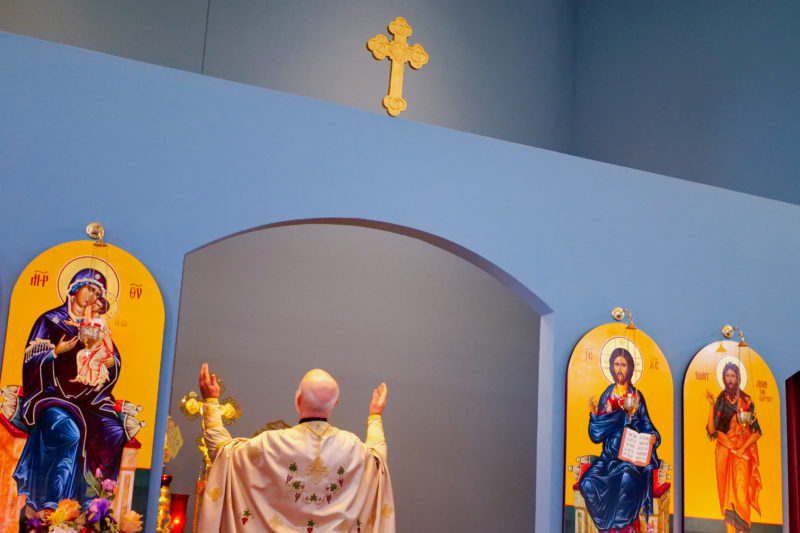
The Rev. David Barr leads a service at Saint Elias Orthodox Church North Campus in Austin, Texas, on Feb. 10, 2021. Less than 1% of Texans identify as Orthodox Christian according to a 2019 Pew Research Center poll. Kirsten Hahn/Reporting Texas
As a rule, in large swaths of Texas, people don’t ask if you go to church; They ask where.
Almost a quarter of Texans are Catholic, and fully half of the state is Protestant, according to a 2019 Pew Research poll. The remaining third encompasses all other faiths, including those who don’t identify with a religion.
However, one seemingly niche religious tradition is outpacing other denominations in growth in the Lone Star State. The Orthodox Church grew by 23,000, or 73 percent, overall in the last 10 years, with some sects reaching nearly 270 percent growth. Texas’ population grew by over 15% in the same period, according to the United States Census Bureau.
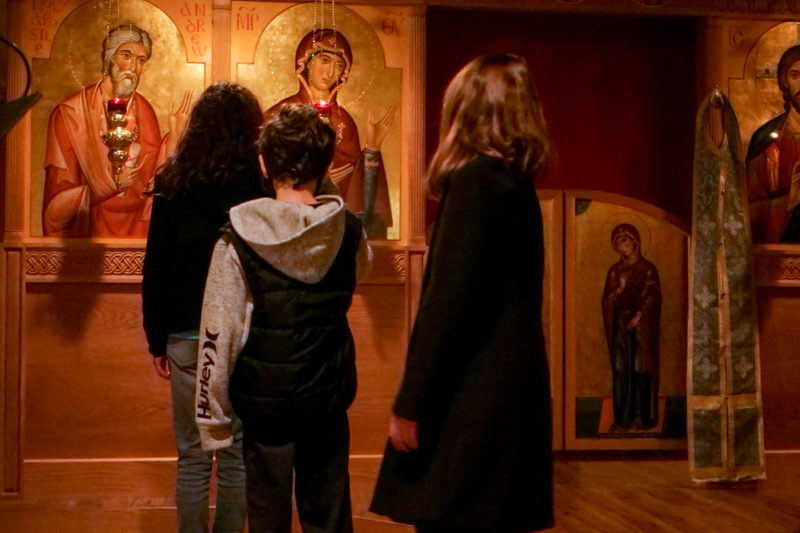
Children bow in front of the religious icons at St. Andrew Orthodox Church in Waco, Texas, following a service on Feb. 10, 2021. The religion has seen explosive growth in Texas, increasing about 73% in 10 years, according to Alexei Krindatch, the national coordinator of the U.S. Second Census of Orthodox Christian Churches. Kirsten Hahn/Reporting Texas
Members say Orthodoxy has remained unchanged since the beginning of Christianity, and its sense of authenticity is drawing new members. Critics say an increasing number of members use this belief to justify fundamentalist or far-right ideals.
U.S. Religion Census national coordinator Alexei Krindatch was surprised by the growth. “It’s huge. It’s really, really big,” Krindatch said. “I never bothered to look at Texas specifically … I was impressed.”
In North America, there are two broad categories of Orthodoxy, Eastern and Oriental. In Texas the number of regular attendees in Eastern Orthodox parishes grew 9% since 2010, compared to 177% in Oriental Orthodox parishes, according to research from Krindatch.
Immigration is a part of the church’s explosive growth, Krindatch said.
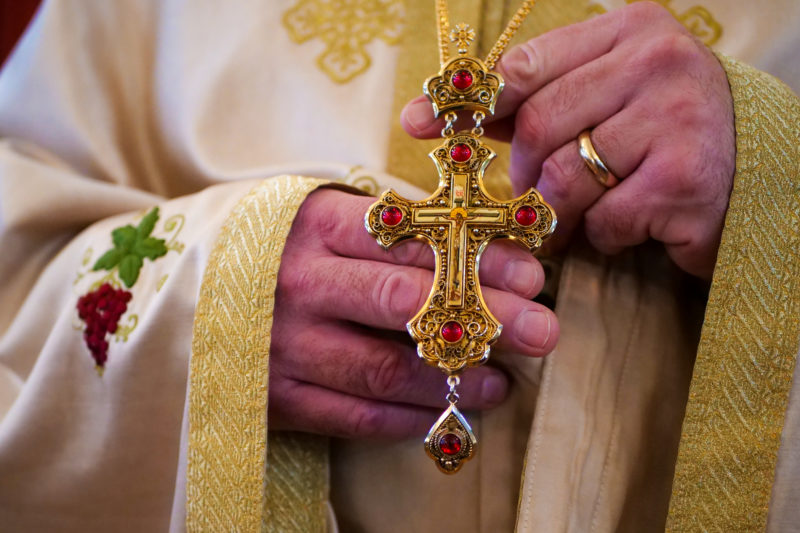
The Very Rev. David Barr holds up his pectoral cross at the Saint Elias Orthodox Church North Campus in Austin, Texas, on Feb. 10, 2021. Kirsten Hahn/Reporting Texas
The growth is particularly striking given that Orthodox churches do not engage in aggressive recruitment. Instead, they focus on theology to attract potential members.
“We don’t go around knocking on doors,” Father Mark Vair said, adding that the church does evangelize but does not “actively recruit people.” Vair is a priest at St. Ephraim in San Antonio.
Vair has seen discrimination against members of the Orthodox church. “I think it maybe makes people, especially some Protestants, feel uncomfortable, to have someone calling themselves the ‘orthodox church’ or the ‘correct church,’” Vair said.
Father David Barr is archpriest at St. Elias in Austin. He says people are looking for “something that hasn’t changed in hundreds, even a couple thousand years.”
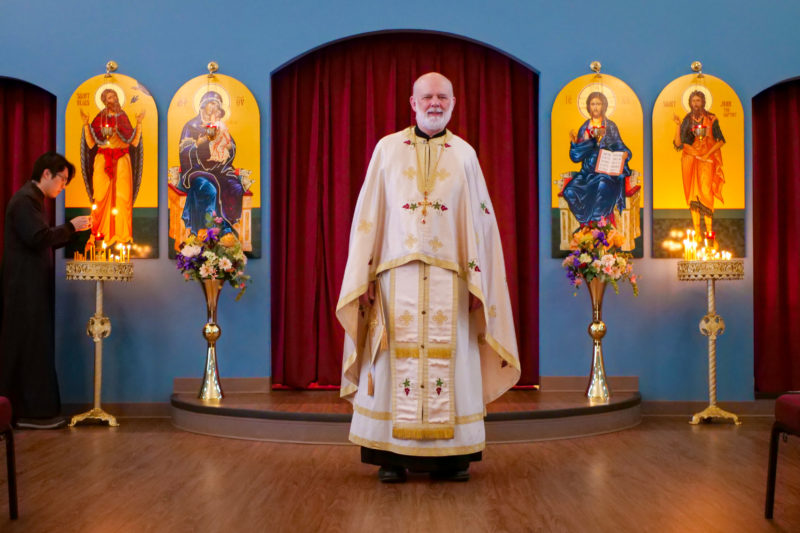
The Very Rev. David Barr stands in front of various icons at Saint Elias Orthodox Church – North Campus in Austin, Texas, on Feb. 10, 2021. Barr credits the religion’s popularity to the church’s unchanging nature and people searching for “something that’s stood the test of time.” Kirsten Hahn/Reporting Texas
“We’re teaching the same thing we taught from the beginning,” Barr said. “You’re not in a church that’s 100 years old, or 150 years old, or even 10 years old,” he added. “You’re part of something that’s stood the test of time.”
Vair pins the growth on a sense of stability and comfort for members. “I really think it’s that ancient authenticity that gets people’s attention,” he said.
Eastern Orthodoxy teaches that Jesus was of two natures, human and divine. After this became the church’s official belief in 451 A.D., Oriental Orthodoxy was born. Oriental Orthodoxy teaches Jesus’ humanity was of only one nature — both holy and man at the same time.
Both denominations teach that their bishops are linked in an unbroken chain originating with Jesus’s apostles.
While some of the growth is due to migration to cities such as Houston and Dallas, a significant share of newcomers come from other traditions.
Eric Ryniker, 37, is a member of St. Sophia in San Antonio. He and his wife joined the church in 2017 after seeing an Orthodox priest speak about the church in relation to Catholicism and Protestantism. Orthodoxy’s holistic approach to faith stood out to Ryniker.
“It’s not just a set of intellectual positions,” he explained. “It’s more of a lifestyle.”
The Orthodox follow a special calendar that includes times of fasting as well as times of celebration.
“It captures your whole life, but it also captures your whole person,” Ryniker said.
Zachary Wingerd is a history professor at Baylor University in Waco. Wingerd discovered Orthodoxy on a trip to Russia in 2001 while on a semester abroad in college.
“Without even understanding the language or understanding exactly what was going on, it gave off the vibe of, ‘there’s a sense of reverence here’. A different type, a more intense sense of reverence,” Wingerd said.
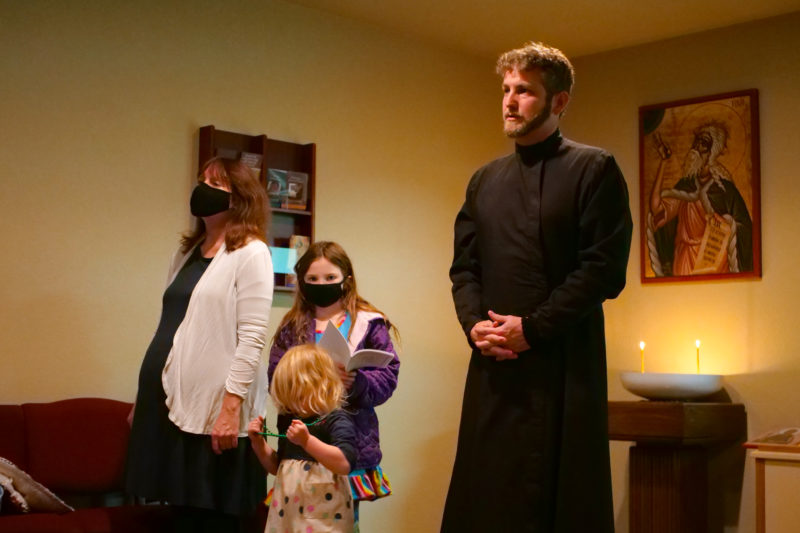
Zachary Wingerd, right, stands with his wife, Lindsey, and his daughters, Genevieve,3, and Juliana, 9, during a service at St. Andrew Orthodox Church in Waco, Texas, on Feb. 10, 2021. Confirmed in 2004, Wingerd serves as a reader during some church services. Kirsten Hahn/Reporting Texas
Wingerd and his wife were confirmed into the Church in 2004 after a yearlong process called catechism, which all Orthodox converts must undertake.
Father Jon Finley is director of missions and evangelism for the Antiochian Archdiocese of North America and a priest in Santa Barbara, Calif.
“During COVID, our churches, our existing, established parishes — they’ve been growing,” Finley said. “I’ve probably heard it from 15, 20 pastors.”
People from other Christian backgrounds are curious about the Orthodox church but are wary of being conspicuously absent from their current churches on Sunday mornings, Finley said. The transition to virtual services gives some of those people freedom to try Orthodox services, he added.
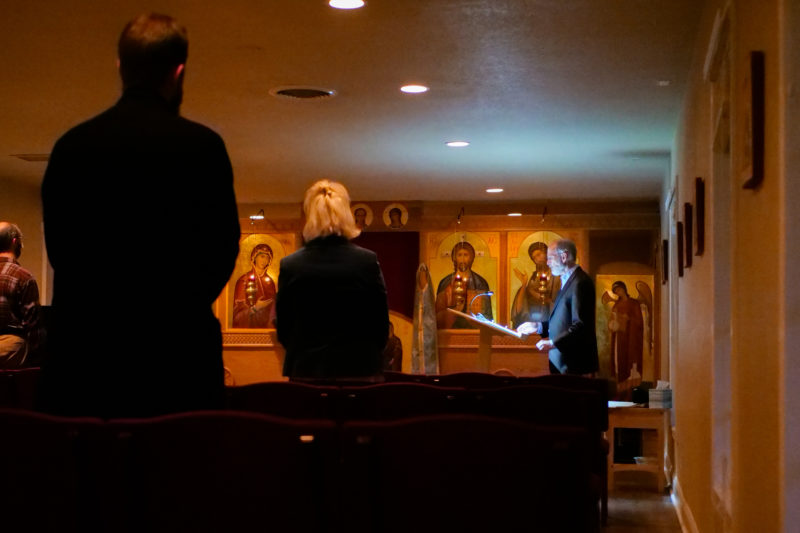
Doyle Young, sings and directs responses to Psalms and hymns during a service at St. Andrew Orthodox Church in Waco, Texas, on Feb. 10, 2021. Kirsten Hahn/Reporting Texas
Some claim extreme far-right views in the name of Orthodoxy, using its strong historical traditions to justify white nationalist behavior, among other extreme conservative beliefs.
At the infamous 2017 white nationalist rally in Charlottesville, Va., Orthodox convert and white supremacist Matthew Heimbach waved a flag that read “Orthodoxy or Death.” He wrote that “Regional and racial identity is a fundamental principle of Christianity, [much] to the dismay of Leftists.” The church excommunicated Heimbach after the incident.
A blog called Orthodox Reflections publishes articles that deny the existence of the COVID-19 pandemic and promote anti-vaccine ideas. One post titled “Orthodox Bishops – Accept You Were Duped on COVID and Move On,” calls pandemic-related precautions like social distancing and wearing masks “politically motivated pseudo-science.”
A few Orthodox priests organized a Jericho March around the U.S. Capitol on Jan. 6, the same day as the Capitol insurrection. In the Bible story, God destroyed the city of Jericho to prove loyalty to the Israelites after he commanded them to march around the city’s walls. The Jan. 6 marchers went in explicit support of Donald Trump’s attempt to overthrow the U.S. presidential election.
There are signs of rising fundamentalism in Orthodoxy. Some seminaries go so far as to reject potential students who do not homeschool their children.
Father Josiah Trenham of St. Andrew in Riverside, Calif., has a strong following but is despised among other Orthodox clergy. He is on the Southern Poverty Law Center’s Hate Watch list for homophobic remarks.
“Tell the LGBT tolerance tyrants, this lavender mafia, these homofascists, these rainbow radicals, that they are not welcome to promote their anti-religious and anti-civilizational propaganda in your nations,” Trenham said at an anti-LGBTQ gathering in Tbilisi, Georgia.
There are also progressive voices in the church. Online publication The Wheel calls for a “creative reimagination of the Church’s social identity and role in public discourse.” Orthodoxy In Dialogue identifies and calls out misbehavior in the church, which has drawn the ire of Trenham and his supporters.
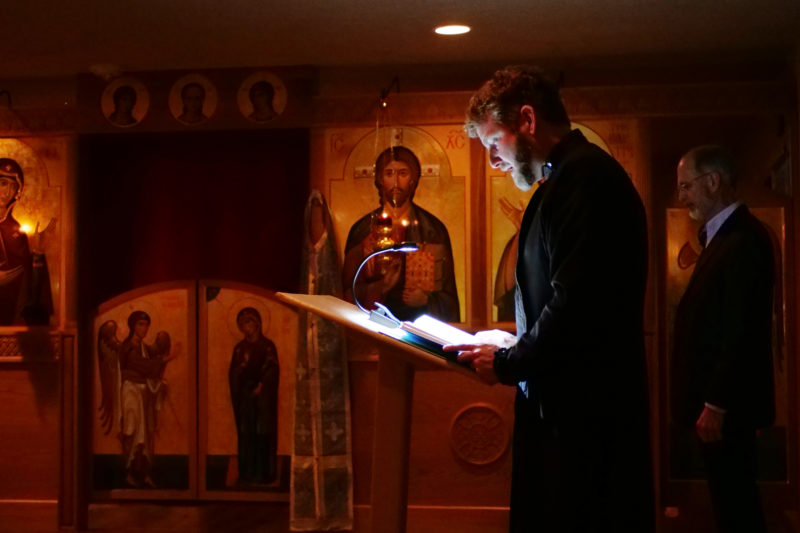
Zachary Wingerd, a reader for St. Andrew Orthodox Church, leads services on Feb. 10, 2021. Kirsten/Reporting Texas
Wingerd said divisions in the faith can be counterproductive and that labels which separate rather than unite can damage the church.
“Orthodoxy is meant for everyone,” Wingerd said. “We’re all in this together.”